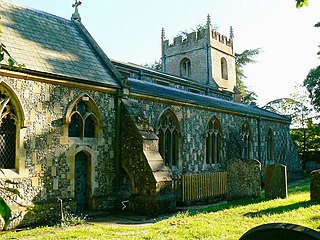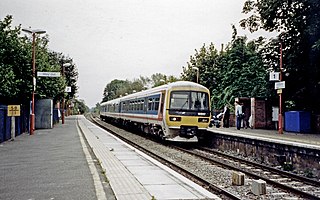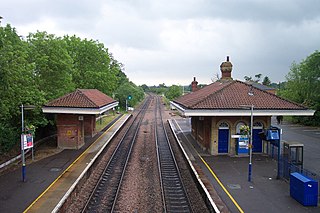
Great Bedwyn is a village and civil parish in east Wiltshire, England. The village is on the River Dun about 4.5 miles (7.2 km) southwest of Hungerford, 14 miles (23 km) southeast of Swindon and 6 miles (9.7 km) southeast of Marlborough.

Burbage is a village and civil parish in the Vale of Pewsey, Wiltshire, England. It is about 6 miles (9.7 km) south of Marlborough and 20 miles (32 km) west of Newbury.

Grafton is a civil parish in Wiltshire, England, in the Vale of Pewsey about 7 miles (11 km) southeast of Marlborough. Its main settlement is the village of East Grafton, on the A338 Burbage - Hungerford road; the parish includes the village of Wilton and the hamlets of West Grafton, Marten and Wexcombe.

Midgham railway station, formerly known as Woolhampton railway station, is a railway station in the English county of Berkshire. It is located in the village of Woolhampton, but takes its current name from the village of Midgham that lies some 2 miles (3.2 km) away.

Kintbury railway station serves the village of Kintbury in Berkshire, England. It is situated on the Reading to Taunton Line, 58 miles 38 chains from London Paddington.

The Hungerford railway station is a railway station that serves the town of Hungerford in Berkshire, England. It is 61 miles 43 chains measured from the zero point at London Paddington.

Bedwyn railway station serves the village of Great Bedwyn in Wiltshire, England. It is 66 miles 33 chains from the zero point at London Paddington. Along with Pewsey station, it serves the market town of Marlborough which is 6 miles (10 km) away. A bus from the town connects with most trains on Mondays to Saturdays.

Pewsey railway station serves the village of Pewsey in the county of Wiltshire, England. The station is on the Berks and Hants line, 75 miles 26 chains measured from the zero point at London Paddington, and served by intercity trains operated by Great Western Railway between London and the West Country. The average journey time to Paddington from Pewsey is just over an hour. Services between Pewsey and Bedwyn, the next station up the line, are infrequent, most eastbound services next calling at Hungerford, Newbury or Reading instead. This is because Bedwyn was the most westerly point of the Network SouthEast on this line, while Pewsey was an InterCity station.

Westbury railway station serves the town of Westbury in Wiltshire, England. The station is managed by Great Western Railway.

Chippenham railway station is on the Great Western Main Line (GWML) in South West England, serving the town of Chippenham, Wiltshire. It is 93 miles 76 chains down the line from the zero point at London Paddington and is situated between Swindon and Bath Spa on the GWML. The Wessex Main Line diverges from the GWML to the southwest of Chippenham and runs to Trowbridge via Melksham.
The Wilts, Somerset and Weymouth Railway (WS&WR) was an early railway company in south-western England. It obtained Parliamentary powers in 1845 to build a railway from near Chippenham in Wiltshire, southward to Salisbury and Weymouth in Dorset. It opened the first part of the network but found it impossible to raise further money and sold its line to the Great Western Railway (GWR) in 1850.

The Berks and Hants Railway comprised two railway lines built simultaneously by the Great Western Railway (GWR) south and west from Reading in an attempt to keep the London and South Western Railway (LSWR) out of the area that it considered to be its territory in England.
The Langport and Castle Cary Railway is a railway line from Castle Cary railway station to Cogload Junction near Taunton, Somerset, England, which reduced the length of the journey from London to Penzance by 20+1⁄4 miles (32.6 km).

Grafton and Burbage railway station served the villages of Burbage and East and West Grafton in Wiltshire, England. The station was on the Midland and South Western Junction Railway. It opened in May 1882 as the northern terminus of the southern section of the Swindon, Marlborough and Andover Railway and became a through station when the line from Swindon was completed through a new Marlborough station and the Great Western Railway's Savernake station in February 1883.

Collingbourne railway station served the village of Collingbourne Ducis in Wiltshire, England. It was on the Midland and South Western Junction Railway (M&SWJR) and opened on 1 May 1882 on the southern section of the Swindon, Marlborough and Andover Railway (SM&AR) which at that stage terminated at the-then next station to the north, Grafton and Burbage. In 1883, the SM&AR gained running rights over the Great Western Railway branch from Savernake Low Level to Marlborough and through services started between Swindon Town and Andover Junction railway station, and on down the Sprat and Winkle Line to Southampton. The same year, the Swindon and Cheltenham Extension Railway (S&CER) opened north of Swindon as far as Cirencester and in 1884 the SM&AR and the S&CER merged to form the M&SWJR. The line was completed as a through-route from the Midlands to the south coast by the completion of the northern end of the route between Cirencester and Cheltenham in 1891.

Marlborough railway stations refers to the two railway stations which served Marlborough, Wiltshire, England; the town supported two railway routes and Savernake, the junction station at first, later had a second station.
The Midland and South Western Junction Railway (M&SWJR) was an independent railway built to form a north–south link between the Midland Railway and the London and South Western Railway in England, allowing the Midland and other companies' trains to reach the port of Southampton. The M&SWJR was formed in 1884 from the amalgamation of the Swindon, Marlborough and Andover Railway and the Swindon and Cheltenham Extension Railway. The line was absorbed by the Great Western Railway at the 1923 grouping of the railways, and became part of British Railways on nationalisation in 1948. The railway closed to passengers in 1961, and to goods between 1964 and 1970. A small part of it has been reopened as the heritage Swindon and Cricklade Railway.
The Stert and Westbury Railway was opened by the Great Western Railway Company in 1900 in Wiltshire, England. It shortened the distance between London Paddington station and Weymouth, and since 1906 has also formed part of the Reading to Taunton line for a shorter journey from London to Penzance.

The Reading–Taunton line is a major branch of the Great Western Main Line from which it diverges at Reading railway station. It runs to Cogload Junction where it joins the Bristol to Exeter and Penzance line.

Savernake is a civil parish immediately south and southeast of Marlborough in Wiltshire, England. The settlements in the parish are the hamlets of Cadley,Clench Common and Forest Hill. Savernake Forest covers the eastern half of the parish.

















